7.1 Definition of access to the resource
7.2 Allocation regulation
7.3 Social compensation
7.4 Conclusions
Traditional measures regulating access to the resource are different from those regulating how it is shared. The first determine which categories of the population may have access to the resource, the second distribute it among the members of those categories.
Before Colbert's Ordinance of 1681, coastal dwellers were granted exclusive access to shoreweed, and official legislation has maintained this access to this day. Coastal communities have completed distribution by allocating sections of the shore to families and even individuals.
Although in theory driftweed belongs to everyone, coastal residents resent the arrival of farmers from the interior, well-equipped for the harvest with their heavy carts and strong horses. Many are tempted to reserve for themselves this driftweed which is often their only source of income, and in 1912 the seaweed harvesters of Lanildut decided that they alone had the right to harvest driftweed within their commune.
Another practice of the seaweed harvesters of Plounéour-Trez was to await the arrival of peasants from Goulven or Brignogan and then to sell them portions of the current harvest.
Shoreweed are all those plants growing on the rocks which are exposed at low tide. They include many species, but only Fucaceae, Laminaria and Gigartina are exploited.
7.1.2.1 Seaweed belongs to the inhabitants of coastal communes
This rule is strictly enforced and no outsiders may participate in the harvest, even as the paid employees of a resident. Not even boats from other communes may be used. "Seaweed may be transported in boats from the commune only" read a municipal ordinance in Landéda in 1845. A similar restriction applied to horses in Roscoff.
These restrictions benefitted local fishermen who offered their harvesting services to local farmers in exchange for butter, meat, firewood and other farm products.
It was not until 1890, however, that the precise qualifications of a resident of the commune were established. Commune residents were:
- people living within the community,
- those residing there more than six months of the year,
- those owning more than 15 ares of farmland.
These regulations were abrogated shortly thereafter, in 1898, by municipal ordinances such as the one in Plouguerneau which stated that:
Anyone unable to prove his residence in the commune is denied the right to participate in the harvest, even if he owns land in Plouguerneau.
A similar step was taken in 1923 in the neighbouring commune of Guissény:
No one residing in another commune may participate in the seaweed harvest in the commune of Guissény, no matter what the area of the land he farms in the commune of Guissény might be.
The communes might, however, come to an agreement among themselves. By virtue of historic rights acquired when Lannilis and Landéda formed the single parish of Ploudiner, the residents of Lannilis retain the right to harvest shoreweed on the coast of Landéda, though at a later date. They may have access to the shore only after several days of harvesting by local residents. Regulations in 1954 established cutting dates as follows:
Landéda: from 6 May to 30 June
Lannilis: from 16 May to 30 June.
Similarly, no one questioned the traditional right of the inhabitants of Larret to continue to cut black seaweed along the littoral of Porspoder after they became separate communes in 1970.
A social measure which will be spoken of later allowed the widows of men killed in the service of their country to hire harvesters from outside the commune.
7.1.2.2 The definition of a coastal dweller may be qualified
Residents of some communes may harvest seaweed off the coast of their own neighbourhood only. This is the case in Roscoff, where municipal laws establish methods for resource allocation.
Excessive fractioning of resource allocation may adversely affect families and even individuals. These diverse forms of resource allocation will be discussed on page 28.
7.1.2.3 Should seaweed belong exclusively to the commune?
Allocating shore seaweed to coastal dwellers alone creates a marketing problem. This seaweed becomes an "attached" property. It cannot be used or sold outside the commune.
Although well-known for his analysis of and commentary on Colbert's Ordinance, Valin (1760) offered no explanation for this ban on sales outside the commune. Seaweed would surely have proved useful to farmers outside coastal parishes. In North Finistère, for example, where more than half of the communes are agricultural, fertilizer is scarce.
Resolution of this problem began with the decree of 4 July, 1853, allowing mayors of coastal communes to permit surplus seaweed to be sold outside the commune when they judged it necessary. Landowners who were not residents of the commune were permitted to remove from the commune only that portion of seaweed intended for their own use.
A decree of 8 February, 1868, ended all discrimination. This free circulation was legally perpetuated thereafter, although it was not always immediately accepted at the local level.
One example of local resistance is the continued ban on external sales during the first eight days of the harvest, until all local land has been supplied with fertilizer. In other cases, especially in Haut-Léon, the prohibition of exports was related to competition between seaweed for agricultural use and seaweed for industry. On Batz Island, until 1930, for instance, no seaweed was burned. The entire yield was reserved for agricultural use.
In the Pagan region, shore plots are allocated to all families residing in the commune. The tenants of each plot hold the exclusive right to harvest any shoreweed, Laminaria and lichen found there.
Industrial exploitation of Laminaria is well-established, the first industrially organized iodine factory having opened at Conquet in 1828. Except for periods of very low tide (of a coefficient superior to 100), when the upper level of the seaweed bed is exposed, Laminaria must be harvested by boat. For this reason, official legislation, which requires that all fishermen be registered sailors, requires that all seaweed harvesters be registered as well. All seaweed found on islands, islets and in areas inaccessible by foot is also allotted to registered seaweed harvesters.
No further allocation is made among fishermen in these zones. While habit and preference determine the work area of each professional, few of them resent the presence of seaweed harvesters from other communes. In this instance, belonging to a profession is more important than being a member of the community.
The preceding section dealt with the principles determining regulation of access and allocation. The following outlines the practical side of these measures or how resource allocation is actually accomplished.
Regulation states that driftweed harvesting is open to everyone in all locations (res nullius). This theoretical freedom has been modified by custom. Driftweed is, in fact, available to harvesters in one of two forms:
- it is still adrift, or
- it has been cast upon the shore.
A description of the prevailing customs in the commune of Porspoder will illustrate these two cases. We will then discuss variations in different zones.
7.2.1.1 The example of Porspoder
a) Seaweed still adrift. This seaweed cannot be allocated. Access is open and the first person to bring it to dry land becomes the owner (principle of first occupancy). The avidity of seaweed harvesters is well-known and the temptation to appropriate seaweed collected by others is great.
The harvesters' work must therefore be organized and rules enforced at the local level. When the tide goes out, the harvester follows its movement, forming rows of piles to be built up as he proceeds. The first pile in line is marked by some distinctive identifying object, such as a whip, jacket, sack or stone. Anyone who sets out his piles in a disorderly fashion is reprimanded by his neighbours who suspect that he might be doing so in order to steal some of their piles.
The piles are usually begun outside the backwash area, but this involves too wide an area on a flat shore and the harvester would rather risk the tide and form his piles as he works. He anchors the pile between his feet, or bends over it as he works to prevent the current from carrying it off. Should the sea carry the pile away, despite his precautions, anyone may catch and claim it.
b) Driftweed cast upon shore. Seaweed cast upon the shore is shared, but the form of allocation may vary, depending upon:
- the number of persons involved in the harvest;
- the amount of seaweed on shore;
- the location.
There are three forms of allocation:
(i) "Frip" - Under this system, allocation takes place before the harvest begins. Adjustment is usually made, however, to control the avidity of some of those present.(ii) "Touch-lod" is the name given to the system by which attribution occurs before the harvest but also prorata to the persons present. This system ensures a more egalitarian attribution.
(iii) "Boutin" - This name applies to a pro-rata sharing among all participants after a collective harvest.
These three forms of sharing vary in the following ways:
- The more people present, the more "Touch-lod" is called for.- If there are very large quantities of seaweed, sharing becomes unnecessary. Each person will be able to gather enough to meet his needs.
- A method of sharing is sometimes imposed by the location of the harvest. On certain shores (Pors-an-toulou, Enez Meloun), tradition dictates that "Touch-lod" be practised, while on others (Aochou Meloun, Mazou), it has never been used.
Description of the different methods:
(i) "Frip": The harvest may not begin until sunrise, which is marked when the Four lighthouse is extinguished. While the light is still shining, harvesters visit the shore, choosing the best sites. The earliest arrivals are therefore favoured. Once a spot is chosen, the harvester marks it with his tool, the "croc" (a short of hook), gathering a little seaweed around it. It is possible to retain several spots but it will later be seen that this is generally useless.
It is forbidden to begin work as long as the light is shining. As soon as it stops, work begins, and each harvester must mark as his the place he has reserved. Ownership is not truly established until the harvester has marked off the area around himself, removing seaweed from the sand (Figure 5). This demarcation of the work area is usually arranged perpendicular to the shore front, but this is not obligatory. Only one place per person may be marked with a "croc". To increase their harvest, then, each member of each family must come to the shore with a croc, or the head of the family may mark a place for each child. Once the seaweed is marked off and provisionally collected, women and children leave. Only the men remain to collect and cart off the seaweed which has been gathered up. This custom favours the fastest workers and especially those who arrive very early on shore.
Figure 5 - The "frip" method. 1/. Waiting for the light to be extinguished.
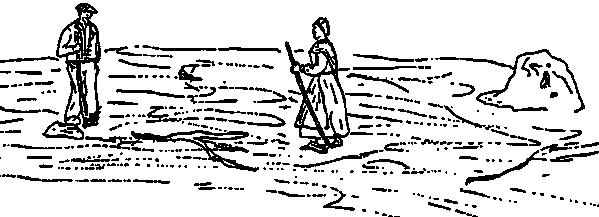
Figure 5 - The "frip" method. 2/. Marking off plots.
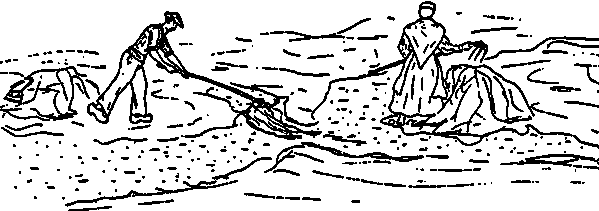
Figure 5 - The "frip" method. 3/. Loading the harvest.
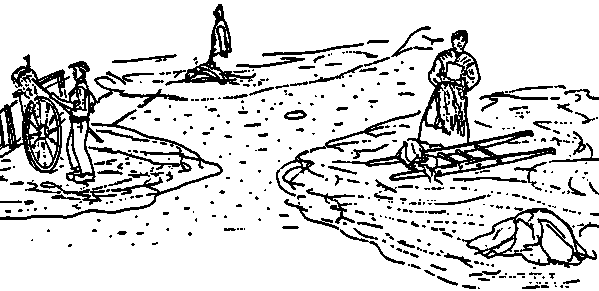
(ii) "Touch-lod": This is a more egalitarian custom; involving real sharing. Places are drawn at random. As soon as the lighthouse light goes out, those wishing to participate in the harvest are counted. There will be as many shares as people present, children and infants included. Families are present in their largest possible number to take advantage of this distribution. The quantity of seaweed found on shore is evaluated by number of cartloads. This traditional method is surprisingly accurate.
To facilitate this expose, we will simulate a situation: Ten families totalling 48 persons are present on shore. The oldest, or those of acknowledged moral or intellectual authority, have evaluated the quantity of seaweed at 64 cartloads.
Step 1: There are 64 cartloads for 48 persons.
|
Family |
A |
B |
C |
D |
E |
F |
G |
H |
I |
J |
|
Number of Family Members |
4 |
5 |
7 |
8 |
3 |
2 |
4 |
5 |
4 |
6 |
Step 2: These are divided into two equal groups.
|
A |
B |
C |
D |
|
4 |
5 |
7 |
8 |
|
E |
F |
G |
H |
I |
J |
|
3 |
2 |
4 |
5 |
4 |
6 |
An imaginary line is drawn to divide the shore into two equal parts. At this point there are 2 x 32 cartloads for 24 persons each. By drawing straws ("kenna plouz"), it is decided which group will take the right side and which will take the left.
Step 3: One more division is made to form four teams of 12 persons. Twelve cartloads are allotted to each team. The position of each team is also determined by drawing straws:
|
A |
A |
|
4 |
8 |
|
C |
B |
|
7 |
5 |
|
H |
G |
E |
|
5 |
4 |
3 |
|
J |
I |
F |
|
6 |
4 |
2 |
Step 4: Each group divides its space in proportion to the number of persons present. The quantity of seaweed in each person's plot is evaluated and arrangements are made to eliminate inequity by re-distribution later. If re-distribution is not feasible, after the harvest a new line or cross is made in the sand with the handle of a tool. The shore divided, work may begin. At this point, all those not involved in transporting the seaweed leave. School-age children go to school. The ebb tide sometimes deposits large quantities of additional seaweed. This is declared either free to all ("frip") or to be shared ("touch-lod").
(iii) "Boutin": Sometimes, when the seaweed is scattered among the rocks, it is difficult to estimate quantity. In such a situation, those persons concerned, who are usually of limited means, harvest the seaweed collectively, carrying the bundles away to the dune on their backs. When harvesting is completed, these bundles are counted and shared equally by all those who worked. Less common than the two preceding methods, boutin is usually practised on shores accessible only by foot, by people who are not farmers or seamen and have neither horses nor boats.
(iv) Conclusion: The following graph illustrates the use of "frip" and "touch-lod":
Figure 6. Conditions for the practice of the two methods.
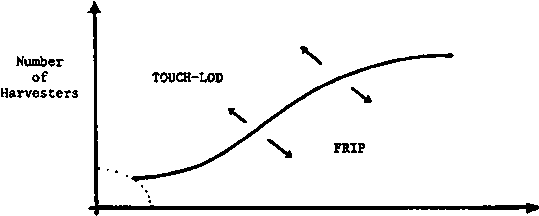
"Frip" is the method used where seaweed is present in dense quantities and harvesters are few. When the number of harvesters increases, "touch-lod" must be practised. When there are few harvesters and little seaweed, however, "frip" is satisfactory.
- The two methods are occasionally practised together. "Touch-lod" is used first for the preliminary divisions. Harvesters inside each of the areas established may then decide whether or not their seaweed is "frip".- As previously mentioned, location may determine the method used. "Touch-lod" has always been practised on certain shores.
- It should be added that our informants noted a tendency to abandon "touch-lod" in favour of "frip", due perhaps to a progressive disorganization of social structures and discipline. As the demand for seaweed for fertilizer decreases, and the price drops, harvesters prefer the greater flexibility of the "frip" method.
7.2.1.2 Geographic variability of custom
Driftweed harvesting has been permitted, in all areas and at all times, even at night, since Colbert's ordinance in 1681. This freedom, summarized by the words
E lec'h ma zeuz tre ha lano
Peb hini lak e hano*
has not always been strictly preserved.
* "Where there are ebb and flow, anyone may write his name".
a) Individual reserves. (1) No allocation problem arises in the case of seaweed which has drifted onto uninhabited islands and islets. It can only belong to registered sailors able to harvest it from their boats. (2) In the case of driftweed not yet on shore, there is rarely any allocation made. The widely accepted custom is that this seaweed becomes the property of the first person able to gather it. It must first, of course, be completely removed from the water and amassed out of reach of the current. Should the tide carry it seaward it again becomes available to all.
Some seaweed professionals lay claim to floating seaweed. To do so they make small piles of seaweed, protruding from the water and lodged on rocks which form a polygon. The area thus marked off represents their property. This practice has been observed in Landéda only. More frequent is the practice of dredging driftweed beneath the surface ("silla bijin"), or collecting it before it reaches the shore. Municipalities have taken steps to curb such practices, which are unfair to those harvesters waiting on shore:
When registered seamen harvest driftweed by boat, they should be prohibited from using any methods or manoeuvres which prevent the seaweed from drifting to shore, and should be fined for violations of this prohibition (Landunvez, 1904).It is furthermore forbidden to gather floating seaweed with iron rakes (Roscoff, 1845).
Another practice to be noted, common in several places and in the islands of the Molène Archipelago, consists of erecting rock dams to trap seaweed during the ebb tide. This is an obvious example of appropriation of the resource by intervention before it becomes accessible to everyone.
b) The "frip" principle of seaweed sharing. This method is common all along the coast. The harvester must simply place his tools on the area he has retained, sometimes before the light is extinguished, sometimes after (Lanildut, Plouescat). In every locale, each person may place only one tool. The only real differences are in the methods used to mark off each section. In the region between le Conquet and Ploudalmézeau, harvesters try to mark their area as quickly as possible by making a sort of furrow in the seaweed, while beyond this region, towards Roscoff, harvesters proceed from a central point and progressively enlarge their section by forming small piles (Figure 7).
Figure 7. Progressive enlargement of the harvesting area

When each person's section is established, allocation is complete. Only the problem of transportation remains. Here, as in some aspects of the harvest mentioned previously, local regulation must restrain greed.
It must be recalled that it is expressly forbidden to place too many tools, or to position harnessed teams, on the seaweed (Le Conquet 1950).
This system of sharing favours those who work quickly, and sometimes leads, in the resulting confusion of activity, to disputes over bundles of seaweed. Quarrels are frequent but even though a single stipe need often be cut in half to satisfy both parties claiming to own it, these shore disputes or "fachuri an aod" are quickly forgotten.
c) Seaweed sharing by random drawing for plots. The name given this practice varies from region to region (Figure 8) and its form may also vary.
Figure 8. Local names of the system
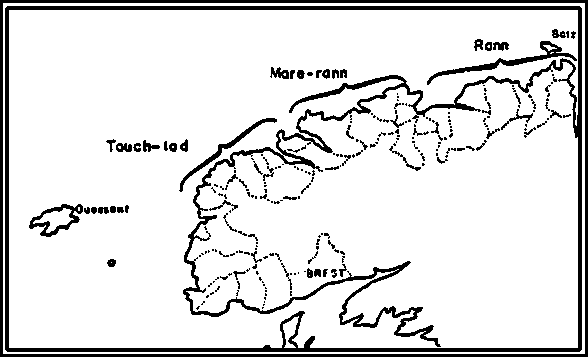
(i) This practice seems to have disappeared from the region south of Aber Ildut after the war. Our informants state that it was replaced by frip exclusively.
(ii) To the north, at Porspoder, our informants remember that after 1930 touch-lod was progressively replaced by frip.
(iii) Further north, if we can rely on the recollections of our informants, drawing for plots was the usual practice.
(iv) In other communes, it seems that there were some "frip" and some "touch-lod" zones. This is the case for Porspoder, Tréompan-Ploudalmézeau, Landéda, and Plouguerneau.
(v) Eligibility for lot allocation may vary:
- Porspoder: Everyone present on shore is eligible, regardless of age or gender.- Landunvez: All family members are eligible, including children, who need not be present.
- Lampaul-Ploudalmézeau: All persons present over 10 years of age are eligible.
- Landéda and Plouguerneau: Same conditions as at Porspoder.
- Brignogan: As above.
- Plounéour: Only men are entitled to a plot. On Mondays, eligibility is extended to children over 10. Women are eligible only when widowed or when their husbands are absent on military service.
(vi) Not all harvest areas are allotted by dividing the shore into two parts. In Plounéour-Trez and throughout the Haut-Léon, those in charge practise another system. Once the light is extinguished, a preliminary division is made, called "An trouc'h braz" or "the big cut", creating two zones where harvesters may work as they please.
Within these two zones two, three or four more divisions are made. Each person may choose one, but may not leave it once he enters. There is a slightly different system on Batz Island, called "tenna chetou" ("drawing for lots"), consisting of drawing for lots in the two zones. Each family places a small object - a stone, a shell, etc. - in a hat, and beach plots are assigned by drawing these objects from the hat.
(vii) Lot assignment usually begins when the lighthouse light is extinguished. In the Pagan region, however, and especially at Brignogan and Plounéour, distribution occurs at mid-ebb tide. The advantage of this system is that it standardizes the conditions of resource allocation and that allocation occurs at a time when driftweed is totally accessible.
d) Allocation following a collective harvest. This practice, observed in Porspoder, has also been used in the Pagan region and in Ouessant (Thoer, 1909). Collective harvesting was adopted to meet community needs in Ouessant, whose men are absent at sea for long periods of time. Agricultural work, as well as seaweed harvesting, is accomplished collectively, at both the neighbourhood and village levels.
Methods of allocation of shore seaweed correspond to three geographic zones (Figure 9).
- The first zone, of which the Pagan region is the centre, is characterized by a complex system for allocation of the shore and its plant resources.- The second zone is located to the west of the first and includes the estuary area, where systems are more simple.
- The third and last is a double zone, which extends from the eastern (Haut-Léon) boundaries to the southern (littoral of the canon of Saint-Renan) boundaries of the first two zones.
Figure 9. Method of shoreweed attribution
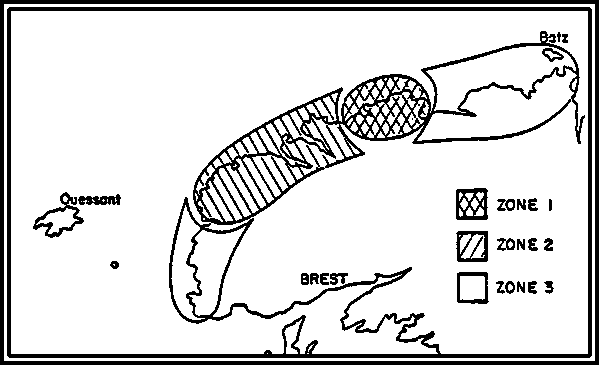
7.2.2.1 The example of the Pagan region
The Pagan region, although difficult to define, theoretically regroups the communes of Plouguerneau, Guissény, Kerlouan, Brignogan and Plounéour. The practice of allocating a portion of the shore to each family in proportion to its size is found in the last three communes only. Allocation is valid for four years and is the equivalent of a permit. The family has exclusive right to all plant species found in its portion within tidal limits. Small islands which are found within the family's portion but which are not accessible by foot during spring tides are excluded. Seaweed from these islands is never shared, but is considered bottom weed and is therefore reserved to registered seamen.
We will describe here the practices current in Plounéour-Trez, the commune for which the most precise data were available.
Every four years (1901, 1905, 1909, etc.) in early January, a list of all the families and individuals composing the local population is compiled. When the list is established, the inhabitants are called to the town hall, one neighbourhood at a time, to make their declarations. On 4 January, 1901, for example, residents were invited to present their claims in the following order:
7:00 - 9:00 - Bourg
9:00 - 12:00 - Kerurus
12:00 - 15:00 - Douar ar Pont
15:00 - 17:00 - Trévigny
Each family member is entitled to one plot. The head of the family declares the number to which his family is entitled and indicates where his family's plot should be distributed over the rocks. If, for example, there were 13 family members, the head of the family could claim his 13 shares, six on one rock, four on another, three on a third.
At the end of the day, the town secretary should have a total number of plots equal to the total population. If not, an inquiry is made to determine who has cheated or who has not claimed his share. Anyone who cheats forfeits his seaweed rights and his lots are divided among the other harvesters.
Residents who do not wish to harvest the seaweed due to them may sell it, but only to other residents of the commune. This transaction must be made public and the declaration of sale, specifying the sum paid and the number of lots involved, must be approved at the town hall.
Persons who leave the commune when farm leases expire may sell their shore plots to whomever replaces them, even if the new tenant did not previously reside in the commune.
Once all transactions are made, each rock or group of rocks represents a certain number of shares. For example, eight families possessing 50 shares propose to exploit a given group of rocks. On a day of their choosing, they go to the rocks to decide how they should be divided. They begin by establishing the "trouc'h koz", or the median line separating the zone into two equal stocks. Each half is then divided into 25 parts. When necessary, these parts are further subdivided to equal the number of shares required.
When the distribution is complete, the boundaries of each zone are identified ("ar merkou") and no further changes may be made for the next four years. Each family may exploit its plot as it chooses, annually or bi-annually.
This system permits a fair distribution of the resource. It is well organized and managed by the municipal authority.
7.2.2.2 Sharing the shore in the Abers region
Here, lot allocation is accomplished differently. Allocation is not renewable. Each family holds specific shore lots. If a family member dies or a family moves away, those shares become available and must be negotiated for with neighbours. In Porspoder most harvesters are full-time farmers who frequently move to new farmland. When they leave their land they also leave their shore rights and the new occupant assumes both.
When the black seaweed harvest begins, people go to their respective places, which are completely cleared in three to four days. Only after this time may harvesters leave their places, and shore sections left unexploited become the property of the first to occupy them. When the shore is cleared, farmers usually return to their fields. Only professional seaweed harvesters go with their boats to continue the harvest on the small islands not accessible at low tide.
There are many small islands in the waters off the Wrac'h and Benoit Estuaries. Because inhabitants of these islands own and have duly registered deeds to their land, they claim the exclusive right to harvest seaweed found there. In practice, however, they would reserve this seaweed until all seaweed on other shores adjacent to the mainland had been cut. Protest from seaweed professionals put an end to this unfair practice in 1920.
There is really no allocation of this resource. Free movement and exploitation are the rule, as we have seen. It is interesting, however, to note measures taken by the seaweed harvesting profession since 1978. Aware of the tremendous harvesting potential of the newly modernized fleet, the professionals decided to limit its number to 75 fishing units, in order to better distribute to each the quotas set by scientists and industry. This represents a form of resource allocation and regulation of resource sharing. Seventy-five units are sufficient to exploit the Laminaria beds of North Brittany.
7.3.1 Days for the needy
7.3.2 Special privileges extended to widows
7.3.3 Regulating competition
7.3.4 Safety measures
7.3.5 Intervention by the Church *
Just resource distribution is accomplished by controlling competition and also by direct aid to people in disadvantaged social categories. The needy require assistance and provision must be made for job safety and help in case of accident. In considering these social measures, we must recognize the important role played by the Church and the influence of the Church on the behaviour of seaweed harvesters.
This system, by designating certain days as "Indigents" or "Poor Days", provides for the temporary allocation of the resource to the neediest social groups, whose harvesting potential is limited. Technically, they have access to only baskets, litters and wheelbarrows. When the dates of the harvest are set, it is understood that the needy will begin one, two or three days earlier:
Plouescat: 1 day
Cléder: 2 days
Roscoff: 3 days
This practice has survived until today in the region between Plouescat and Roscoff, although its area of application, which in 1853 included Guissény, has decreased over the years.
Indirect reference to the past existence of Days for the Poor may be found in municipal ordinances of the communes of Plouguerneau (1824), and Landéda (1845):
In order to avoid quarrels and waste, the seaweed cutting period will be the same for all residents of the commune; special privileges will be extended to no one. (Landéda, 1845)The seaweed harvesting period will be the same for all inhabitants, to avoid disputes and waste which resulted in the past when special permission was given to widows and mothers of large families to begin the harvest three tides before others who have the use of horses and wagons. (Plouguerneau, 1824)
Even as early as 1812, the Prefect of Finistère published an ordinance predicting such a measure. There was therefore a progressive reduction of the area in which such privileges were extended to the underprivileged. This seems to have been a voluntary change rather than a gradual erosion of custom. The custom did survive in Haut-Léon, where it was known by several different names: (Figure 10)
Mare ar peurienn, or Tide of the Poor
Mare ar dougerienn, or Porter's Tide
Deiz ar peorienn, or Day of the Poor
Dervez ar Man, or Basket Day.
Figure 10. Geographic extension of the principle of a day for the poor
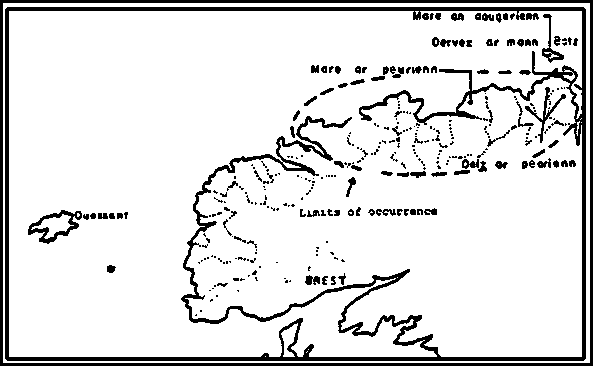
A list of all those persons considered needy is established by the town hall and is revised periodically. Figure 11 illustrates the distribution of the poor in the commune of Plouescat in 1915.
Figure 11. Distribution of the poor in the commune of Plouescat in 1915
Excluded from the list are all those who own wagons and horses, boats or "parterres", small flat boats 2 or 3 metres long which serve as tenders for larger, sloop-type vessels. Because their harvesting potential is evidently much greater than that of those listed as "indigent" it was important to manage resource access to enable the disfavoured to meet their needs.
In Haut-Léon, the black seaweed harvest is far more important than in Bas-Léon. The produce industry requires large quantities of fertilizer and it is vital to make use of all hands on days when harvesting is permitted. Widows, or wives of men in the military, had the right to obtain help outside the commune. This right constitutes an amendment of the principle of exclusive access for coastal commune residents.
This practice has been observed in many areas and at Lampaul-Ploudalmézeau and Landéda in particular. In Landéda, outside help for women was authorized by a mayoral ordinance in 1845:
We authorize each woman whose husband is in the military to employ one worker from outside the commune.
The various methods of allocation promote a just distribution of seaweed resources, proportionate to need. In cases where these measures are not adequate, steps must be taken to limit abusive practices and unfair competition.
Black seaweed can be cut only at low tide. Harvesters must work very quickly and workers specialize to increase yields. Some are cutters, others transporters or wagoneers. The first cut the seaweed, the second carry it to the cart paths and there form piles which the third group, with carts and horses, will transfer to the dune. Because one member of each family (or two, if the family has two teams) is involved in carting and not directly in cutting, yield is unavoidably lessened. A great effort is made, therefore, to minimize time spent on transportation while the tide is out.
7.3.3.1 "Gwir-torchad"
Gwir-torchad is partial transportation of the seaweed. The carts are unloaded at a higher point on shore, out of reach of the returning tide, but below the dune. The gain in time is appreciable, enabling each carter to spend a few minutes cutting between trips. The seaweed has a little time to dry, becoming lighter and easier to transport.
If everyone were to practice "gwir-torchad", entrance to the shore would be blocked. To prevent this, custom, and most communes, require that seaweed be deposited "war an dihorenn", or away from the shore area, before the lighthouses are relit at the end of the day. In Porspoder, any seaweed left on shore overnight became driftweed, accessible to anyone.
Among the exceptions cited are these:
When a seaweed harvester intends to sell a few cartloads of black seaweed to a farmer, he does not want to take up drying space on his portion of the dune, and is allowed to leave that seaweed "gourlenn", or, at sea level.
It is also obvious that the bundles of seaweed lashed together to form a "drome" so bulky that only a part is visible above the water cannot immediately be removed from the area. After the last hour of low tide, and allowing time to convoy them, these "dromes" do not reach dry land before 8 or 9 p.m. For this reason, seaweed harvesters may transport the dromes the next day or, if they choose to work into the night, they are granted special permission to work after sundown, even though the lighthouse has been relit.
In Haut-Léon, special permission is given to harvesters on "Indigents' Days" to place the seaweed, which they must carry on their backs, quite nearby on shore, but out of the water's reach.
7.3.3.2 "Dour-veina"
This technique differs from the former. Rather than being partially accomplished, transportation is deferred until no more cutting can be done. Under this system, all energies can be devoted to harvesting during the authorized cutting period.
In 1844, the mayor Landunvez described the practice briefly in an ordinance Intended to forbid it:
The council, consideringthat certain individuals have developed the undesirable habit of sinking seaweed on the spot as it is cut, so as to accumulate more seaweed during the time meant for its transport,that this operation, called dour-vena, inhibits seaweed reproduction because the rocks used to anchor the seaweed disturb the sea bottom,
and that seaweed detached from the bottom and tossed onshore by the current becomes common property,
the council requests that his Honour the Mayor forbid residents to anchor cut seaweed in this way because of the excessive damage it causes.
The practice consists of cutting the seaweed, stacking it in a nook in the rocks and anchoring it in place with heavy stones. The next day, at the next tide, the stones are removed, more seaweed is added to the pile and the stones are replaced as the tide turns. The harvest of two or three days may be stored in this fashion. If stored any longer, deprived in this way of the light and air needed to carry out the physiological functions of respiration and photosynthesis, it would deteriorate. Once the shore is cleared and cutting has ceased, harvesters who have risked using this practice can transport their seaweed to the dune at their leisure.
The general tendency is to prohibit the practice of dour-veina (Figure 12). In Landéda, however, a municipal text of 1864 permits sinking harvested seaweed in certain urgent situations: if, for example, one of the ropes binding the pile were caught among the rocks, the immobilized pile could be sunk until the next day.
Figure 12. Extension of the ban on sinking seaweed Practice of Dour-Veina

7.3.3.3 Coordinating harvest seasons
Some islets are accessible by foot only at mid-tide or later. They can be reached by boat at the beginning of ebb tide. It has always been the custom that cutting begins only when harvesters are able to reach the islets by foot. Harvesters with boats are therefore forbidden to begin earlier. This custom prevails for the rock known as Golhedoc, near Guissény, and many at Plouescat.
Effective organization and some form of police presence are necessary to prevent accidents during the general upheaval which accompanies the black seaweed harvest season.
At Guissény in 1833, the succession of carts crossing the village was required to follow a circular course: those going to the shore passing by way of the "Pen c'hroas", those leaving the shore taking the main thoroughfare. In Cléder, boats and dromes must be placed at least 2 metres away from the cart paths, while in Roscoff they can be stationed in specific areas only. Local regulations often impose further restrictions to ensure public safety.
In 1904, after prohibiting all seaweed harvesting between 1 November and 14 April, the mayor of Landunvez stated:
This restriction on harvesting during bad weather will preserve the lives of many of our sailors, who would otherwise imprudently risk illness and accident.
A similar concern was expressed in Plouescat in 1850:
In respect for the lives of seaweed harvesters, who would be exposed to great danger in any other season, we must restrict the seaweed cutting season to the month of May.
A complementary measure appeared in 1862, stating that the mayor reserved the right, in the event of a storm or inclement weather, to alter the opening dates to protect the public.
Another example of concern for public safety is found in 1852 at Lampaul-Ploudalmézeau where the mayor limited participation in driftweed harvesting to children over the age of nine, on the grounds that "Parents allow even very young children to take part in the harvest despite intemperate weather which is often damaging to their health".
In 1845 the mayor of Landéda prohibited the gathering of seaweed by swimmers. This measure, by keeping people away from the shore at night, was also a safety measure.
There are many such examples of official concern for public safety during the harvest.
There was a general ban on night-time harvesting. Although successive modifications sometimes permitted limited harvesting of driftweed at night, the general restriction on harvesting shoreweed at night remained in force.
The lighthouse is the undisputed arbiter of night and day. Morning begins when the light is extinguished, night when it is relit. Before the existence of lighthouses, a ranger or seaweed warden officially signalled night and day, sometimes accompanied by a drumroll, as in Porspoder. For many years, however, the coast has been dotted with so many lights that there is no point from which a light is not visible. Only in heavy fog can a harvester now be in doubt about the official beginning or closing of a harvest day (Figure 13).
* The author wishes to acknowledge the invaluable collaboration of Mr. J.L. Le Floc'h in the preparation of this section.
As previously mentioned on page 14, the opening dates and duration of the seaweed cutting season were established by parish administrators until the Revolution. Civil authorities did not then assume total responsibility. The continuing influence of the church is seen in the fact that harvesting on Sundays and holidays was still prohibited. In the Léon, a heavily Catholic region, this ban includes religious holidays and some holidays of civil origin. On Sundays and Feasts of Obligation (Christmas, Ascension, 15 August and All Saints' Day) when the church requires attendance at mass, all work, including seaweed harvesting, is forbidden.
Seven other feasts or holy days are celebrated by a high mass at which attendance is not required. These are New Year's Day (The Circumcision), 2 February (The Purification), 25 March (The Annunciation), 24 June (Saint John the Baptist's Day), 8 September (Nativity of the Virgin), 8 December (Conception of the Virgin), and 26 December (Saint Stephen's Day). On these days the harvest may not begin until noon.
The list of half-day holidays was increased by tradition, or local clergy, to include Candlemass (2 February), Shrove Tuesday, Ash Wednesday, Good Friday, Monday and Tuesday of Easter Week, Monday and Tuesday of Pentecost, the Feast of the Sacred Heart, and All Souls' Day. Harvesting is prohibited until noon on all these days, except Monday and Tuesday of Easter and Pentecost, when it is prohibited all day. Armistice Day, 11 November, is also commemorated by a mass and considered a half-holiday.
More half days were observed before 1801, when many were eliminated by the Concordat agreed upon by Napoleon I and Pius VII. Napoleon evidently preferred that the people work rather than attend mass. Our field research indicates that local custom may cause great variation in the observance of these holidays. Data for Figure 14, correlating religious holidays and harvesting bans, was provided by further research and interviews with the older residents of each commune.
Figure 14. Religious holidays and harvesting bans
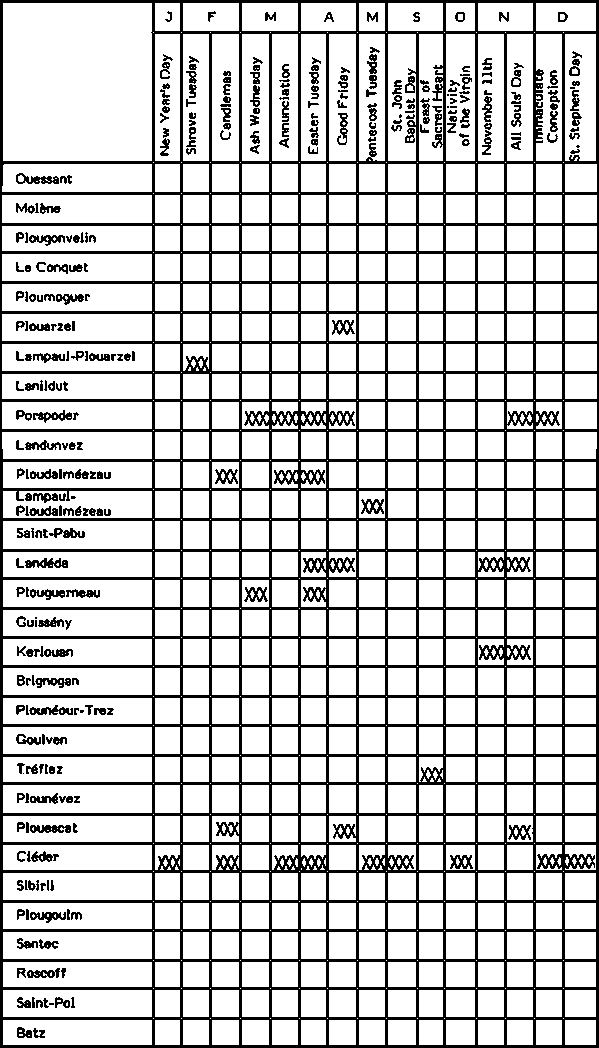
The purpose of the half-day ban on harvesting appears two-fold:
- to encourage attendance at mass, and
- to avoid giving an unfair advantage to those harvesters who do not attend mass.
Moreover, the "fabrique", a civil body responsible for administering parish finances, derived a portion of its income from certain rocks reserved for its use. In 1845, for example, the "Roc'h Melen'Vraz" rocks were reserved for the fabrique of Santec to subsidize church maintenance.
Until World War II, seaweed was a major source of income for the people living along the coast of the Léon. Such an important resource required effective management. Although seaweed harvesters were thought to be concerned with stock conservation, most management measures dealt with organizing seaweed exploitation.
Two systems for the allocation of driftweed, "frip" and "touch-lod", evolved in coastal areas. Originally reserved for coastal communes, the harvest zones were subsequently redivided and fractioned by coastal populations until each individual was allotted a portion of the shore.
Although tradition has not carried the same weight in each zone studied, it can be stated that
- in areas of intense seaweed exploitation, traditional methods have been preserved;- where there is little seaweed harvesting activity, many traditional methods were abandoned in favour of simpler and more flexible methods.
Variability may be geographic or historical.
We may conclude that past intensification of exploitation led to the creation of traditional management methods. For example, regulation of exploitation brought about a shift from collective benefit from the resource to individual benefit. This idea that intensification led to management is reinforced by the recent limiting of the seaweed fleet to 75 units. The licensing system allows a limited number of boats exclusive benefits from, and therefore the appropriation of, a marine resource.